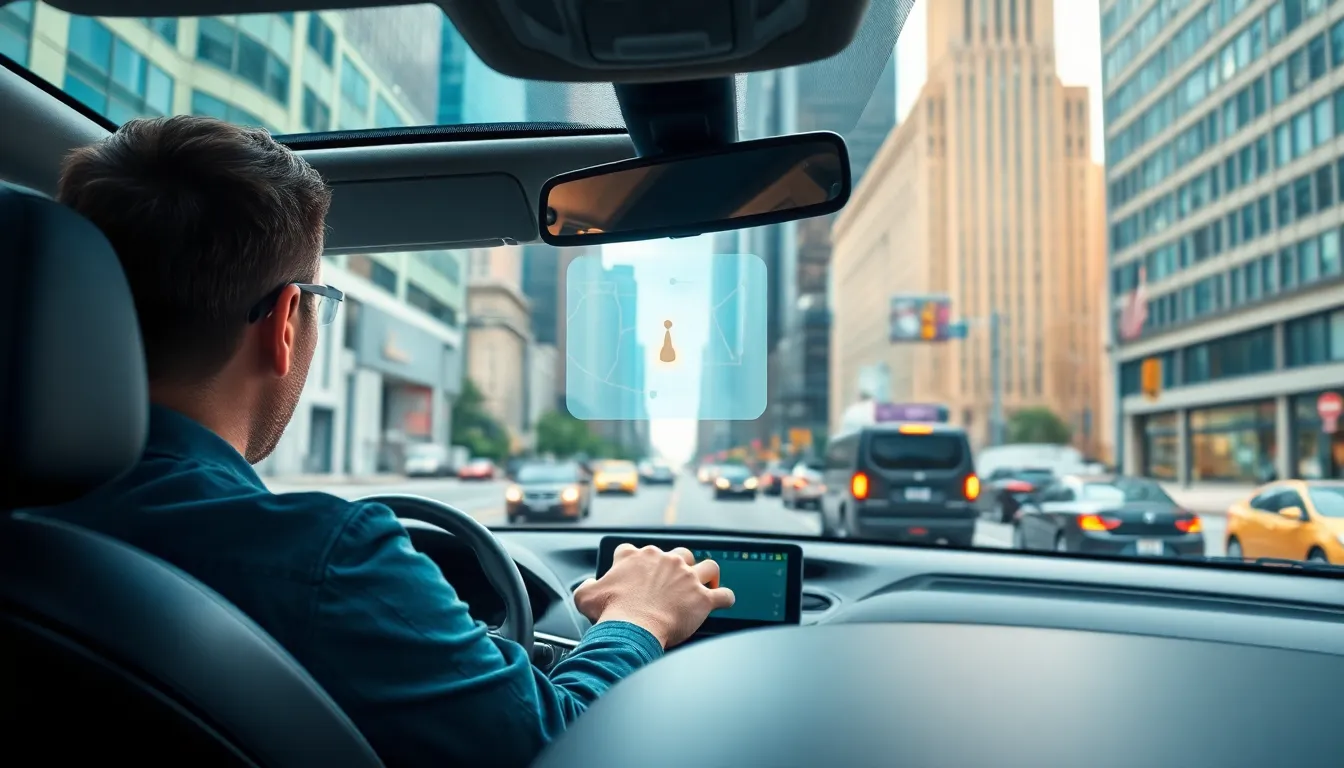In a world where cars are more than just metal boxes on wheels, the rise of car augmented reality (AR) is turning heads and revving engines. Imagine cruising down the road while your car’s dashboard transforms into a high-tech command center, guiding you with real-time data and interactive features. It’s like having a co-pilot that never asks for snacks!
Understanding Car AR
Car augmented reality (AR) technology enhances driving by transforming the dashboard into an interactive command center. This advancement offers drivers real-time data, effectively serving as a co-pilot.
What Is Car AR?
Car AR refers to the integration of augmented reality into vehicles, creating digital overlays on real-world environments. Examples include navigation prompts, speed displays, and hazard alerts projected onto the windshield. These features help drivers maintain focus on the road while accessing vital information seamlessly. Moreover, car AR utilizes various sensors, cameras, and displays to deliver an immersive experience. By providing contextual information, this technology improves decision-making and safety during driving.
How Car AR Works
Car AR operates by combining data from the vehicle’s onboard systems and external sensors. Cameras capture the surrounding environment in real-time while GPS and inertial measurement units track location and movement. Data processing units analyze inputs and generate relevant overlays. For instance, when a driver approaches a turn, navigation prompts appear on the windshield to guide them. Display technologies such as head-up displays showcase this information without obstructing the driver’s view. As a result, car AR enhances situational awareness, making driving safer and more intuitive.
Benefits of Car AR

Car AR significantly enhances the driving experience by providing drivers with vital information easily. This technology offers various benefits, primarily in navigation and safety.
Enhanced Navigation
Drivers gain real-time navigation guidance through augmented reality overlays. Navigation prompts appear directly on the windshield, reducing head movement while following directions. Visual cues, such as arrows and lane guidance, appear in the driver’s line of sight, simplifying navigation. With map data integrated into the AR system, drivers receive precise information about traffic conditions and road hazards. This seamless integration allows for efficient route adjustments based on real-time traffic updates, ensuring timely arrivals at destinations.
Improved Safety Features
Safety is a primary advantage of Car AR technology. Enhanced situational awareness benefits drivers significantly, with critical alerts projected onto the windshield. Hazard warnings appear prominently, alerting drivers to potential obstacles and dangers on the road. Collision warnings enhance decision-making by providing immediate feedback, reducing reaction times. In addition, speed displays maintain compliance with speed limits while avoiding distractions. The convergence of valuable data and intuitive interfaces boosts overall road safety for drivers and passengers alike.
Applications of Car AR
Car AR technology has various applications that significantly enhance driving experiences and safety on the road.
Augmented Reality Dashboards
Augmented reality dashboards transform traditional displays into interactive interfaces that present crucial data. Drivers access information such as speed, navigation prompts, and system alerts without shifting focus from the road. These dashboards utilize real-time data from onboard sensors and external feeds to create a seamless flow of information. Visual overlays improve situational awareness, ensuring critical updates appear directly in the driver’s line of sight. This integration allows for quick comprehension and decision-making, reducing potential distractions. Additionally, customizing settings can provide drivers with a personalized interface, enhancing user experience and increasing comfort levels during travel.
AR in Driver Assistance Systems
AR in driver assistance systems enhances safety and situational awareness through dynamic visual prompts. Alerts for lane departures and proximity warnings appear as overlays on the windshield, providing drivers with vital information in real-time. Systems process data from cameras and sensors positioned around the vehicle, ensuring accuracy when displaying hazards. These visual aids reduce the time needed for drivers to react to potential threats, improving overall road safety. Enhanced navigation details help in adjusting routes dynamically based on traffic conditions. Ultimately, implementing AR into driver assistance enriches the driving experience while promoting safer journeys for all road users.
Future of Car AR
Looking ahead, car augmented reality holds immense potential for transforming driving experiences and safety. Innovative improvements are set to enhance features and address emerging needs.
Potential Developments
Emerging technologies will enhance Car AR systems with improved sensor capabilities and more precise data integration. Several manufacturers are exploring advanced holographic displays, allowing drivers to interact with virtual elements seamlessly. Integration of artificial intelligence may streamline information processing and personalize user experiences based on driving habits. Many companies are also investing in 5G connectivity, which will enable real-time data analysis and updates, enhancing navigation and hazard alerts. Future iterations may utilize vehicle-to-everything communication to improve situational awareness by sharing information among vehicles, infrastructure, and pedestrians.
Challenges to Overcome
Developing Car AR faces several challenges that impact implementation and user safety. One significant concern involves ensuring data accuracy and reliability from various sources, as reliance on faulty information can lead to dangerous situations. Regulatory standards must evolve to encompass augmented reality features, ensuring consistent safety measures across manufacturers. Additionally, driver distraction remains a critical issue; balancing realistic overlays with minimal interruption will be essential for maintaining focus on the road. Privacy concerns regarding data collection and usage will also require addressing to foster consumer trust in these technologies.
Car augmented reality is reshaping the way people interact with their vehicles. By seamlessly integrating vital information into the driver’s line of sight, it enhances both safety and navigation. This technology not only minimizes distractions but also empowers drivers to make informed decisions quickly.
As the automotive industry continues to innovate, the future of car AR looks promising. With advancements in holographic displays and AI integration on the horizon, drivers can expect even more personalized and intuitive experiences. Addressing challenges like data accuracy and privacy will be crucial for widespread adoption. Ultimately, car AR is set to redefine modern driving, making it safer and more enjoyable for everyone on the road.
